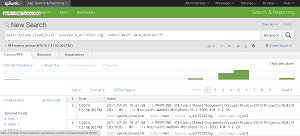Splunk Cloud Guarantees Uptime
Splunk Inc. today announced several updates to its cloud service for analyzing machine-generated Big Data.
Splunk Cloud now features what the company calls the industry's first 100 percent uptime service-level agreement (SLA), lower prices and a free online sandbox in which developers and users can play around with data files.
The SLA is possible through built-in high availability and redundacy in the Software as a Service (SaaS) offering's single-tenant cloud architecture. Spunk Cloud also avoids system-wide outages by delivering dedicated cloud environments to individual customers, the company said, and uses Splunk software to monitor the service. "This is why we're the only machine-data analytics service to offer a 100 percent uptime SLA," the company said. The service can scale from service plans starting at 5GB per day to plans allowing 5TB per day.
The cloud service provides the functionality found in the company's on-premises Splunk Enterprise platform for operational intelligence. Users can search, analyze and visualize machine-generated data from any source, such as Web sites, applications, databases, servers, networks, sensors, mobile devices, virtual machines, telecommunications equipment and so on. The data can be analyzed to provide business insights, monitor critical applications and infrastructure, respond to and avoid cyber-security threats, and learn about customer behavior and buying habits, among other scenarios.
The service also provides access to more than 500 of the company's apps -- such as for enterprise security, VMware and Amazon Web Services (AWS) cloud -- to use out-of-the-box, customizable alerts, reports and dashboards.
 [Click on image for larger view.]Using the Splunk Cloud Sandbox (source: Splunk Inc.)
[Click on image for larger view.]Using the Splunk Cloud Sandbox (source: Splunk Inc.)
From the home screen, users can navigate to search and interact with data; correlate different data streams and analyze trends; identify and alert on patterns, outliers and exceptions; and rapidly visualize and share insights through the reports and dashboards.
Customers also get access to the Splunk developer platform and its RESTful APIs and SDKs.
Security is enhanced, the company said, by the individual environments that don't mix data from other customers. Also, Splunk Cloud instances operate in a Virtual Private Cloud (VPC), so all data moving around in the cloud is isolated from other traffic.
Also new in the updated service is access to an online sandbox in which users can "mess around" with analytics and visualizations on their own data files or pre-populated example data sets supplied by Splunk. Using the sandbox requires a short account registration and e-mail verification. Within a few minutes, you can start the sandbox and use a wizard to upload your data files, although this must be one at a time.
After a data file is uploaded, you're presented with a search interface that provides tabs to show events, display statistics or build visualizations. For example, it took only a minute or so to upload an IIS log file and see "events" that were culled from the data, primarily time stamps in my useless test case.
Along with the search tab, the sandbox provides tabs for reports, alerts, dashboards and for Pivot analysis.
The sandbox account lasts for 15 days, but up to three sandboxes can be set up over the lifetime of a single account.
Splunk Cloud itself has a 33 percent discounted price resulting from "operational efficiency."
The service is now available in the United States and Canada, with a standard plan starting at $675 per month for up to 5GB per day. Scaling to the 5TB per day limit switches to an annual billing plan.
"We’ve been seeing organizations start to move their mission-critical applications to the cloud, but many still see availability and uptime as a significant barrier," the company quoted 451 Research analyst Dennis Callaghan as saying. "By guaranteeing 100 percent uptime in its SLA, Splunk Cloud should help ease some of the performance monitoring and visibility concerns associated with applications and infrastructure running in the cloud."
Posted by David Ramel on 08/05/2014 at 11:31 AM